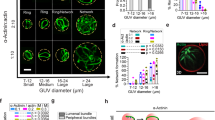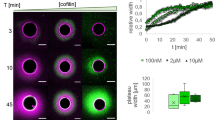Abstract
Structure formation and constant reorganization of the actin cytoskeleton are key requirements for the function of living cells. Here we show that a minimal reconstituted system consisting of actin filaments, crosslinking molecules and molecular-motor filaments exhibits a generic mechanism of structure formation, characterized by a broad distribution of cluster sizes. We demonstrate that the growth of the structures depends on the intricate balance between crosslinker-induced stabilization and simultaneous destabilization by molecular motors, a mechanism analogous to nucleation and growth in passive systems. We also show that the intricate interplay between force generation, coarsening and connectivity is responsible for the highly dynamic process of structure formation in this heterogeneous active gel, and that these competing mechanisms result in anomalous transport, reminiscent of intracellular dynamics.
This is a preview of subscription content, access via your institution
Access options
Subscribe to this journal
Receive 12 print issues and online access
$259.00 per year
only $21.58 per issue
Buy this article
- Purchase on Springer Link
- Instant access to full article PDF
Prices may be subject to local taxes which are calculated during checkout







Similar content being viewed by others
References
LeGoff, L., Amblard, F. & Furst, E. Motor-driven dynamics in actin-myosin networks. Phys. Rev. Lett. 88, 18101 (2002).
Kruse, K., Joanny, J-F., Juelicher, F., Prost, J. & Sekimoto, K. Asters, vortices, and rotating spirals in active gels of polar filaments. Phys. Rev. Lett. 92, 78101 (2004).
Joanny, J-F., Juelicher, F., Kruse, K. & Prost, J. Hydrodynamic theory for multi-component active polar gels. New. J. Phys. 9, 422 (2007).
Lau, A., Hoffman, B., Davies, A., Crocker, J. & Lubensky, T. Microrheology, stress fluctuations, and active behaviour of living cells. Phys. Rev. Lett. 91, 198101 (2003).
Joanny, J-F. & Prost, J. Active gels as a description of the actin-myosin cytoskeleton. HFSP J. 3, 94–104 (2009).
Fletcher, D. A. & Geissler, P. L. Active biological materials. Annu. Rev. Phys. Chem. 60, 469–486 (2009).
Guerin, T., Prost, J., Martin, P. & Joanny, J-F. Coordination and collective properties of molecular motors: Theory. Curr. Opin. Cell. Biol. 22, 14–20 (2010).
Kane, R. E. Interconversion of structural and contractile actin gels by insertion of myosin during assembly. J. Cell. Biol. 97, 1745–1752 (1983).
Janson, L. W., Kolega, J. & Taylor, D. L. Modulation of contraction by gelation/solation in a reconstituted motile model. J. Cell. Biol. 114, 1005–1015 (1991).
Liverpool, T. B., Marchetti, M. C., Joanny, J-F. & Prost, J. Mechanical response of active gels. Epl-Europhys. Lett. 85, 18007 (2009).
Koenderink, G. H. et al. Liquids and structural glasses special feature: An active biopolymer network controlled by molecular motors. Proc. Natl Acad. Sci. USA 106, 15192–15197 (2009).
Bendix, P. M. et al. A quantitative analysis of contractility in active cytoskeletal protein networks. Biophys. J. 94, 3126–3136 (2008).
Backouche, F., Haviv, L., Groswasser, D. & Bernheim-Groswasser, A. Active gels: Dynamics of patterning and self-organization. Phys. Biol. 3, 264–273 (2006).
Smith, D. et al. Molecular motor-induced instabilities and cross linkers determine biopolymer organization. Biophys. J. 93, 4445–4452 (2007).
Claessens, M. M. A. E., Semmrich, C., Ramos, L. & Bausch, A. R. Helical twist controls the thickness of F-actin bundles. Proc. Natl Acad. Sci. USA 105, 8819–8822 (2008).
Lieleg, O., Claessens, M. M. A. E., Luan, Y. & Bausch, A. R. Transient binding and dissipation in cross-linked actin networks. Phys. Rev. Lett. 101, 108101 (2008).
Metzler, R. & Klafter, J. The random walk’s guide to anomalous diffusion: A fractional dynamics approach. Phys. Rep. 339, 1–77 (2000).
Metzler, R. & Klafter, J. Accelerating Brownian motion: A fractional dynamics approach to fast diffusion. Europhys. Lett. 51, 492–498 (2000).
Weitz, D. A. & Oliveria, M. Fractal structures formed by kinetic aggregation of aqueous gold colloids. Phys. Rev. Lett. 52, 1433–1436 (1984).
Langer, J. S. Theory of spinodal decomposition in alloys. Ann. Phys. 65, 53–86 (1971).
Viscek, T. & Family, F. Dynamic scaling for aggregation of clusters. Phys. Rev. Lett. 52, 1669–1672 (1984).
Effler, J. C. et al. Mitosis-specific mechanosensing and contractile-protein redistribution control cell shape. Curr. Biol. 16, 1962–1967 (2006).
Hoffman, B. D., Massiera, G., Citters, K. M. V. & Crocker, J. C. The consensus mechanics of cultured mammalian cells. Proc. Natl Acad. Sci. USA 103, 10259–10264 (2006).
Gallet, F., Arcizet, D., Bohec, P. & Richert, A. Power spectrum of out-of-equilibrium forces in living cells: Amplitude and frequency dependence. Soft Matter 5, 2947–2953 (2009).
Liverpool, T. B. & Marchetti, M. C. Instabilities of isotropic solutions of active polar filaments. Phys. Rev. Lett. 90, 138102 (2003).
Aranson, I. S. & Tsimring, L. S. Pattern formation of microtubules and motors: Inelastic interaction of polar rods. Phys. Rev. E 71, 50901 (2005).
Juelicher, F., Kruse, K., Prost, J. & Joanny, J-F. Active behaviour of the cytoskeleton. Phys. Rep. 449, 3–28 (2007).
Schmoller, K. M., Lieleg, O. & Bausch, A. R. Structural and viscoelastic properties of actin/filamin networks: Cross-linked versus bundled networks. Biophys. J. 97, 83–89 (2009).
Margossian, S. S. & Lowey, S. Preparation of myosin and its subfragments from rabbit skeletal muscle. Meth. Enzymol. 85, 55–71 (1982).
Spudich, J. A. & Watt, S. The regulation of rabbit skeletal muscle contraction. I. Biochemical studies of the interaction of the tropomyosin-troponin complex with actin and the proteolytic fragments of myosin. J. Biol. Chem. 246, 4866–4871 (1971).
MacLean-Fletcher, S. & Pollard, T. D. Identification of a factor in conventional muscle actin preparations which inhibits actin filament self-association. Biochem. Biophys. Res. Commun. 96, 18–27 (1980).
Vignjevic, D. et al. Formation of filopodia-like bundles in vitro from a dendritic network. J. Cell. Biol. 160, 951–962 (2003).
Crocker, J. C. & Grier, D. G. Methods of digital video microscopy for colloidal studies. J. Colloid. Interface Sci. 179, 298–310 (1996).
Acknowledgements
We gratefully acknowledge technical support by M. Rusp, G. Chmel and K. Vogt. We gratefully acknowledge the financial support of the DFG in the framework of the SFB 863, and partial support in the framework of the German Excellence Initiative by the ‘Nanosystems Initiative Munich’ and the ‘Institute of Advanced Studies’ (TUM-IAS). S.K. and V.S. thank the ‘International Graduate School for Science and Engineering’. V.S. acknowledges support from the Elite Network of Bavaria by the graduate programme CompInt.
Author information
Authors and Affiliations
Contributions
S.K. and A.R.B. designed experiments, carried out and analysed experiments. V.S., S.K. and A.R.B. conceived, carried out and analysed the simulations and wrote the paper.
Corresponding author
Ethics declarations
Competing interests
The authors declare no competing financial interests.
Supplementary information
Supplementary Information
Supplementary Information (PDF 1814 kb)
Supplementary Movie
Supplementary Movie (MOV 517 kb)
Supplementary Movie
Supplementary Movie (MOV 736 kb)
Supplementary Movie
Supplementary Movie (MOV 2433 kb)
Supplementary Movie
Supplementary Movie (MOV 4670 kb)
Rights and permissions
About this article
Cite this article
Köhler, S., Schaller, V. & Bausch, A. Structure formation in active networks. Nature Mater 10, 462–468 (2011). https://doi.org/10.1038/nmat3009
Received:
Accepted:
Published:
Issue Date:
DOI: https://doi.org/10.1038/nmat3009
This article is cited by
-
Cytosolic actin isoforms form networks with different rheological properties that indicate specific biological function
Nature Communications (2023)
-
A deep learning framework for quantitative analysis of actin microridges
npj Systems Biology and Applications (2023)
-
Self-emergent vortex flow of microtubule and kinesin in cell-sized droplets under water/water phase separation
Communications Chemistry (2023)
-
A printable active network actuator built from an engineered biomolecular motor
Nature Materials (2021)
-
Autonomous materials systems from active liquid crystals
Nature Reviews Materials (2021)



